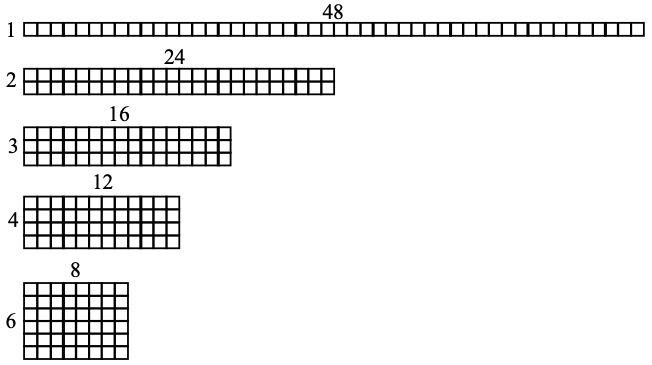General Information
Benchmark Instructional Guide
Connecting Benchmarks/Horizontal Alignment
Terms from the K-12 Glossary
- Composite Number
- Factors
- Prime Number
Vertical Alignment
Previous Benchmarks
Next Benchmarks
Purpose and Instructional Strategies
The purpose of this benchmark is for students to begin understanding factors of whole numbers which sets the foundation for determining prime factorization in grade 6 (MA.6.NSO.3.4).- This benchmark also refers to prime and composite numbers. Prime numbers have exactly two factors, the number one and the number itself (e.g., the number 13 has the factors of 1 and 13 only so it is a prime number). Composite numbers have more than two factors.
- For example, 14 has the factors of 1, 2, 7 and 14. Since this number has more factors than 1 and 14, it is a composite number.
- Instruction may allow students to use divisibility rules to determine the factors of a number.
- All numbers are divisible by 1.
- All even numbers are divisible by 2.
- A number is divisible by 3 if the sum of the digits is divisible by 3.
- A number is divisible by 4 if the 2-digit number in the tens and ones places is divisible by 4.
- A number is divisible by 5 if the number in the ones place is a 0 or 5.
- A number is divisible by 6 if it is an even number and the sum of the digits is divisible by 3.
- A number is divisible by 9 if the sum of the digits is divisible by 9.
- Students should use models (arrays) to determine why a number would be prime or composite.
Common Misconceptions or Errors
- Students may think of the number 1 as a prime number. It is neither prime nor composite.
- Students may also think that all odd numbers are prime.
- Some students may think that larger numbers have more factors. Have students share all factor pairs and how they found the factors.
Strategies to Support Tiered Instruction
- Instruction includes opportunities to identify the factor pairs of whole numbers from 0- 144 with teacher guidance. Students also determine if the number is prime, composite or neither. The teacher refers to the divisibility rules shown above in “Purpose and Instructional Strategies” to support students as they determine the factors of the given number. Students use manipulatives and models (e.g., counters and arrays) to identify factors of the given number.
- For example, the teacher displays the following number: 48. Students draw arrays to determine the factors of 48 (1, 2, 3, 4, 6, 8, 12, 16, 24, 48). Students may use multiplication and skip counting to check factor pairs (e.g., 5 can be ruled out as a factor because 5 × 9 = 45 and 5 × 10 = 50). The teacher asks students if 48 is prime, composite, or neither (composite). This is repeated with additional whole numbers from 0-144.

- For example, the teacher displays the following number: 32. Students are provided 32 counters and use them to create arrays to determine the factors of 32 (1, 2, 4, 8, 16, 32). Students may use multiplication and skip counting to check factor pairs (e.g., 5 can be ruled out as a factor because 5 × 6 = 30 and 5 × 7 = 35). Students may explore using counters to rule out additional numbers as factors (e.g., if you make 6 rows with a total of 32 counters, there will not be an even number in each row). The teacher asks students if 32 is prime, composite, or neither (composite). This is repeated with additional whole numbers from 0- 144.

Instructional Tasks
Instructional Task 1 (MTR.3.1)
Find all the factors for the numbers between 20 and 30. What is the greatest prime number in this set of primes? What is the least prime number in this set of primes?Instructional Items
Instructional Item 1
Select all the statements are true about the number 84.- a. 42 is a factor of 84.
- b. 84 is a composite number.
- c. 84 has exactly 4 distinct factor pairs.
- d. The prime factors of 84 are 2, 6 and 7.
- e. 84 can be written as the product 2 × 2 × 3 × 7.
